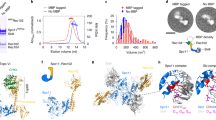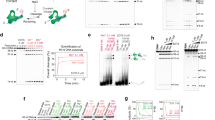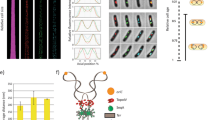Abstract
Type II topoisomerases help regulate DNA topology during transcription, replication and recombination by catalysing DNA strand transfer through transient double-stranded breaks1. All type II topoisomerases described so far are members of a single protein family2. We have cloned and sequenced the genes encoding the A and B subunits of topoisomerase II from the archaeon Sulfolobus shibatae. This enzyme is the first of a new family. It has no similarity with other type II topoisomerases, except for three motifs in the B subunit probably involved in ATP binding and hydrolysis. We also found these motifs in proteins of the Hsp903 and MutL4 families. The A subunit has similarities with four proteins of unknown function. One of them, the Saccharomyces cerevisiae Spo115 protein, is required for the initiation of meiotic recombination. Mutagenesis, performed on SPO11, of the single tyrosine conserved between the five homologues shows that this amino acid is essential for Spo11 activity. By analogy with the mechanism of action of known type II topoisomerases, we suggest that Spo11 catalyses the formation of double-strand breaks that initiate meiotic recombination in S. cerevisiae.
This is a preview of subscription content, access via your institution
Access options
Subscribe to this journal
Receive 51 print issues and online access
$199.00 per year
only $3.90 per issue
Buy this article
- Purchase on Springer Link
- Instant access to full article PDF
Prices may be subject to local taxes which are calculated during checkout
Similar content being viewed by others
References
Wang, J. C. DNA toposiomerases. Annu. Rev. Biochem. 65, 635–692 (1996).
Caron, P. L. & Wang, J. C. Alignment of primary sequences of DNA topoisomerases. In Advances in Pharmacology (ed. Liu, L. F.) 271–297 (Biology Academic, New York, 1994).
Gupta, R. S. Phylogenetic analysis of the 90kDa heat shock family of protein sequences and an examination of the relationship among animal, plants and fungi species. Mol. Biol. Evol. 12, 1063–1073 (1995).
Papadopoulos, N. et al. Mutation of a mutL homolog in hereditary colon cancer. Science 263, 1625–1629 (1994).
Atcheson, C. L., DiDomenico, B., Frackman, S., Esposito, R. E. & Elder, R. T. Isolation, DNA sequence, and regulation of a meiosis-specific eukaryotic recombination gene. Proc. Natl Acad. Sci. USA 84, 8035–8039 (1987).
Woese, C. R. & Fox, G. E. Phylogenetic structure of prokaryotic domain: the primary kingdoms. Proc. Natl Acad. Sci. USA 74, 5088–5090 (1977).
Homes, M. L., Nuttall, S. D. & Dyall-Smith, M. L. Cosntruction and use of halobacterial shuttle vectors and further studies on Haloferax DNA gyrase. J. Bacteriol. 173, 3807–3813 (1991).
Bergerat, A., Gadelle, D. & Forterre, P. Purification of DNA topoisomerase II from the hyperthermophilic Archaeon Sulfolobus shibatae. J. Biol. Chem. 269, 27663–27669 (1994).
Wilson, R. et al. 2.2 Mb of contigous nucleotide sequence from chromosome III of C. elegans. Nature 368, 32–38 (1994).
Lin, Y. & Smith, G. R. Transient, meiosis-induced expression of rec6 and rec12 genes of Schizosaccharomyces pombe. Genetics 136, 769–779 (1994).
Bult, C. J. et al. Complete genome sequence of the methanogenic archaeon Methanococcus jannaschii. Science 273, 1058–1072 (1995).
Woese, C. R., Kandler, O. & Wheelis, M. L. Towards a natural system of organisms: proposal for the domains Archaea, Bacterian and Eucarya. Proc. Natl Acad. Sci. USA 87, 4576–4579 (1990).
Wigley, D. B., Davies, G. J., Dodson, E. J., Maxwell, A. & Dodson, G. Crystal structure of an N-term fragment of the DNA gyrase protein. Nature 351, 624–629 (1991).
Jackson, A. P. & Maxwell, A. Identifying the catalytic residue of the ATPase reaction of DNA gyrase. Proc. Natl Acad. Sci. USA 90, 11232–11236 (1993).
Louvion, F. L., Warth, R. & Picard, D. Two eukaryotic-specific regions of Hsp82 are dispensable for its viability. Proc. Natl Acad. Sci. USA 93, 13937–13942 (1996).
Aronshtam, A. & Marinus, M. G. Dominant negative mutator mutations in the mutL gene of E. coli. Nucleic Acids Res. 24, 2498–2504 (1996).
Sun, H., Treco, D. & Szostak, J. W. Extensive 3′-overhanging, single-stranded DNA associated with the meiosis-specific double-strand breaks at the ARG4 recombination initiation site. Cell 64, 1155–1161 (1991).
Alani, E., Padmore, R. & Kleckner, N. Analysis of wild-type and rad50 mutants of yeast suggests an intimate relationship between meiotic chromosome synapsis and recombination. Cell 61, 419–436 (1990).
de Massy, B., Rocco, V. & Nicolas, A. The nucleotide maping of DNA double-strand breaks at the CYS3 initiation site of meiotic recombination in Saccharomyces cerevisiae. EMBO J. 14, 4589–4598 (1995).
Liu, J., Wu, T.-C. & Lichten, M. The location and structure of double-strand DNA breaks induced during yeast meiosis: evidence for a covalently linked DNA-protein intermediate. EMBO J. 14, 4599–4608 (1995).
Keeney, S. & Kleckner, N. Covalent protein-DNA complexes at 5′ strand termini of meiosis-specific double-strand breaks in yeast. Proc. Natl Acad. Sci. USA 92, 11274–11278 (1995).
Atcheson, C. L. & Esposito, R. E. Meiotic recombination in yeast. Curr. Opin. Genet. Dev. 3, 736–744 (1993).
Cao, L., Alani, E. & Kleckner, N. A pathway for generation and processing of double-strand breaks during meiotic recombination in S. cerevisiae. Cell 61, 1089–1101 (1990).
Loidl, J., Klein, F. & Shertan, H. Homologous pairing is reduced but not abolished in asynaptic mutants of yeast. J. Cell Biol. 125, 1191–1200 (1994).
Goffeau, A. et al. Life with 6000 genes. Science 274, 546–567 (1996).
Szent-Gyorgyi, C. A bipartite operator interacts with a heat shock element to mediate early meiotic induction of Saccharomyces cerevisiae HSP82. Mol. Cell. Biol. 15, 6754–6769 (1995).
Keeney, S., Giroux, C. N. & Kleckner, N. Meiosis-specific DNA double-strand breaks are catalysed by Spoll, a member of a widely conserved protein family. Cell 88, 375–384 (1997).
de Massy, B., Baudat, F. & Nicolas, A. Initiation of meiotic recombination in Saccharomyces cerevisiae haploid meiosis. Proc. Natl Acad. Sci. USA 91, 11929–11933 (1994).
Author information
Authors and Affiliations
Rights and permissions
About this article
Cite this article
Bergerat, A., de Massy, B., Gadelle, D. et al. An atypical topoisomerase II from archaea with implications for meiotic recombination. Nature 386, 414–417 (1997). https://doi.org/10.1038/386414a0
Received:
Accepted:
Issue Date:
DOI: https://doi.org/10.1038/386414a0
This article is cited by
-
Seeding the meiotic DNA break machinery and initiating recombination on chromosome axes
Nature Communications (2024)
-
Molecular mechanisms and regulation of recombination frequency and distribution in plants
Theoretical and Applied Genetics (2024)
-
Tracing the evolution of the plant meiotic molecular machinery
Plant Reproduction (2023)
-
The meiotic topoisomerase VI B subunit (MTOPVIB) is essential for meiotic DNA double-strand break formation in barley (Hordeum vulgare L.)
Plant Reproduction (2023)
-
The proper interplay between the expression of Spo11 splice isoforms and the structure of the pseudoautosomal region promotes XY chromosomes recombination
Cellular and Molecular Life Sciences (2023)
Comments
By submitting a comment you agree to abide by our Terms and Community Guidelines. If you find something abusive or that does not comply with our terms or guidelines please flag it as inappropriate.



